Join me on a nostalgic journey through Amiens, the Little Venice of the North. Explore its iconic Cathedral, wander Saint-Leu's quaint streets, and relax in the tranquil Hortillonnages. Let's uncover the city's charm together!
Discovering a new city is always exciting, but exploring the city where you grew up is a different kind of adventure! Hello fellow travelers, Thomas writing here, and as you may have read in other posts, I'm from the North of France, more specifically, the cute city of Amiens, the capital of Picardie. I've been meaning to write about my hometown for a while now! After all, Amiens was my home for a long time, and it has witnessed my growth, as much as I have witnessed its evolution over the years.
So, let me take you on a journey to discover the most emblematic places in Amiens during a day trip. Our itinerary will include visiting the famous Cathedral of Amiens, wandering around the picturesque district of Saint-Leu, and ending the day with a visit to the tranquil Hortillonnages. This list is far from exhaustive, but it will provide you with a glimpse of my hometown's beauty. Are you ready to explore Amiens with me? Let's go!

IN THIS GUIDE
1. General information
2. History
3. Practical tips
4. Cathedral of Amiens
5. Saint-Leu & Quai Bélu
6. Hortillonages
7. Other places to visit
8. Getting there
9. Eating there
10. Final thoughts
GENERAL INFORMATION
Amiens, my hometown, holds a special place in my heart. Located in northern France, this city has a unique charm that can be easy to miss! With its lovely canals and friendly atmosphere, Amiens may not be the most famous city in France, but it offers a cozy feeling and a rich history that make it worth visiting.
When you explore Amiens, there are three main places you won’t want to miss: the stunning Cathedral of Notre-Dame d'Amiens, the lively Saint-Leu district and the peaceful Hortillonnages. The Cathedral is a great example of Gothic architecture and truly impressive to see. The Saint-Leu district is full of life, especially on Saturdays when the market comes to life with fresh food and local goods. The Hortillonnages, on the other hand, are floating gardens where you can relax and enjoy nature, making it a nice getaway from the city buzz.
But Amiens has much more to offer beyond these three highlights! Among others, the Museum of Picardie is a great place to learn about local art and history, while the House of Jules Verne lets you explore the life of the famous author who lived here. Both of these spots show another side of Amiens and are worth checking out during your visit. As you will see, there’s plenty to discover in this charming city!


HISTORY
Let's take a step back in time and discover the rich history of Amiens. The city's story begins in the Palaeolithic era, around 500,000 years ago, as evidenced by archaeological remains. In pre-Roman times, it was known as "Samarobriva", which translates to "Bridge over the Somme river". The Romans recognized its strategic location and built roads connecting Amiens to other parts of their empire, leading to its growth as a center for trade and Romanization.
Fast forward to the 9th century, when Bishop Saint-Firmin christianized the region. Unfortunately, Amiens was plundered twice by the Normans in the following centuries. But the city's fortunes changed when King Louis VI of France recognised its importance in 1113 and annexed it to the French Crown in 1185.
However, Amiens was not immune to further occupations, including a deceptive attack by Spanish soldiers disguised as peasants who tricked the starving inhabitants to take over the city in 1597. But after a six-month siege, the French finally regained control under Henri IV. Despite the challenges faced by Amiens throughout history, the city has managed to preserve its rich heritage and culture, making it a fascinating destination for history enthusiasts.
During the 18th century's Industrial Revolution, Amiens experienced a prolonged period of peace, leading to its economic growth in the velvet textile industry. The city council initiated major urban planning projects, gradually demolishing the city walls to create broad boulevards around the city center. The railway was also quickly developed, with the first line linking Amiens to Paris built in 1846.
The 20th century cast a dark shadow over Amiens' history, bringing some of its bleakest times. In 1914, with its strategic location to protect Paris, Amiens suffered greatly during WWI. The city bore witness to the bloodiest confrontation of the Great War during the Battle of the Somme in 1916, resulting in 1.2 million casualties. In March 1918, intense bombardments destroyed significant parts of the city, causing its inhabitants to evacuate. Despite efforts to reconstruct the city center, which was already severely damaged during WWI, WWII brought further destruction to Amiens. In 1940, the Germans invaded the city, and even though French and British units put up a fight, the German troops broke through their defenses. The Wehrmacht continued its march towards Paris, and Amiens fell. The British army liberated the city on August 31, 1944, but Amiens had sustained massive damage, with 60% of its buildings destroyed.
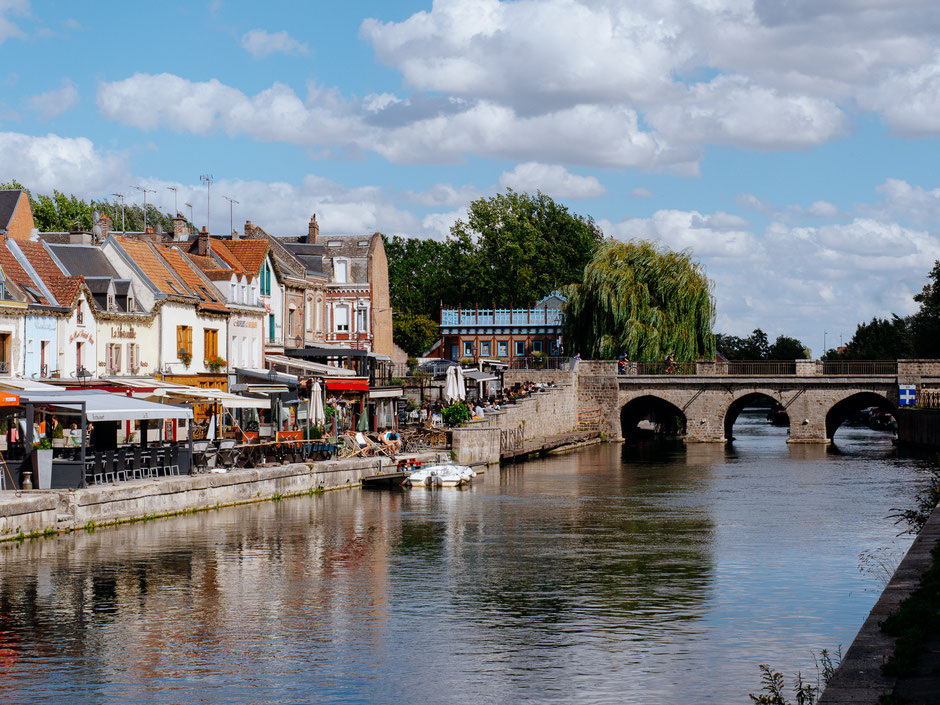
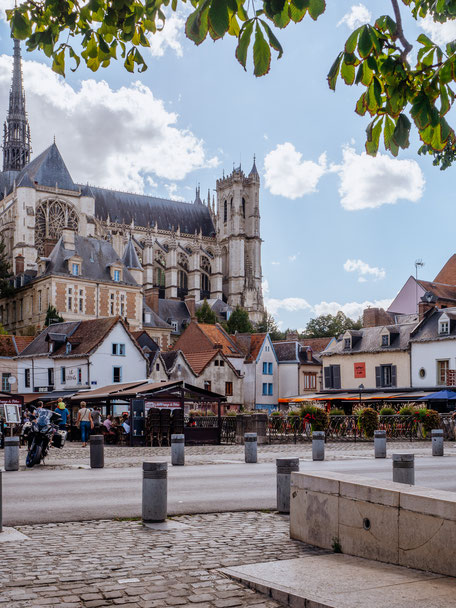
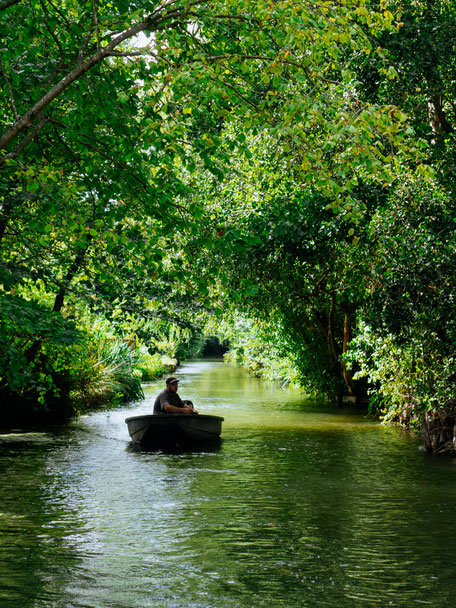
PRATICAL TIPS
BEST TIME TO VISIT
The best time to visit Amiens is from late spring to early autumn (May to September). During these months, the weather is mild and comfortable, making it ideal for walking around the city’s charming streets, exploring the beautiful parks, and taking boat rides through the unique floating gardens, Les Hortillonnages. Summer also brings lively festivals, outdoor markets, and cultural events that really bring the city to life. If you visit in winter, you can enjoy the festive Christmas markets and lights that give Amiens a magical atmosphere.
TRIP DURATION
Amiens is a compact city, so 1 to 2 days is usually enough to see the main sights without rushing. The city makes a great day trip from Paris, thanks to its easy train connections. You can comfortably explore the city in one full day, seeing the stunning Gothic cathedral, wandering the historic center, and enjoying a boat ride through the floating gardens. For a more relaxed visit, two to three days is ideal. This gives you time to explore local museums, try more restaurants, and take day trips to nearby highlights like the Somme battlefields (check our post here) or the beautiful Baie de Somme (check our post here).

BEST 3 THINGS TO DO
1. CATHEDRAL OF NOTRE-DAME D'AMIENS
When visiting Amiens, the Cathedral Notre-Dame d'Amiens is an absolute must-see! This iconic structure is a true masterpiece of architecture, standing out with its stunning façade filled with intricate sculptures and statues. While some might compare it to Notre-Dame de Paris, the Cathedral of Amiens is remarkable in its own right. As the largest cathedral in France, it towers 42.3 meters high and stretches 145 meters in length, with an impressive interior volume of 200,000 cubic meters—enough to fit two Notre-Dame de Paris cathedrals inside!
Construction of the cathedral began in 1220 under Bishop Evrard de Fouilloy, and it was completed around 1290. This incredible achievement highlights the skill and dedication of its builders, especially considering that previous structures on this site had been destroyed by fire and disaster. Despite facing challenges throughout history, including the French Revolution and both World Wars, the Cathedral of Amiens has remained remarkably intact. It now stands as a symbol of resilience for the people of Amiens and a stunning example of Gothic architecture, recognized as a UNESCO World Heritage site since 1981.
| Opening hours |
daily from 8 a.m. to 5.30 p.m.
| Admission |
free of charge (guided tour: 7 EUR)
| For more information about Amiens Cathedral, check our post here |



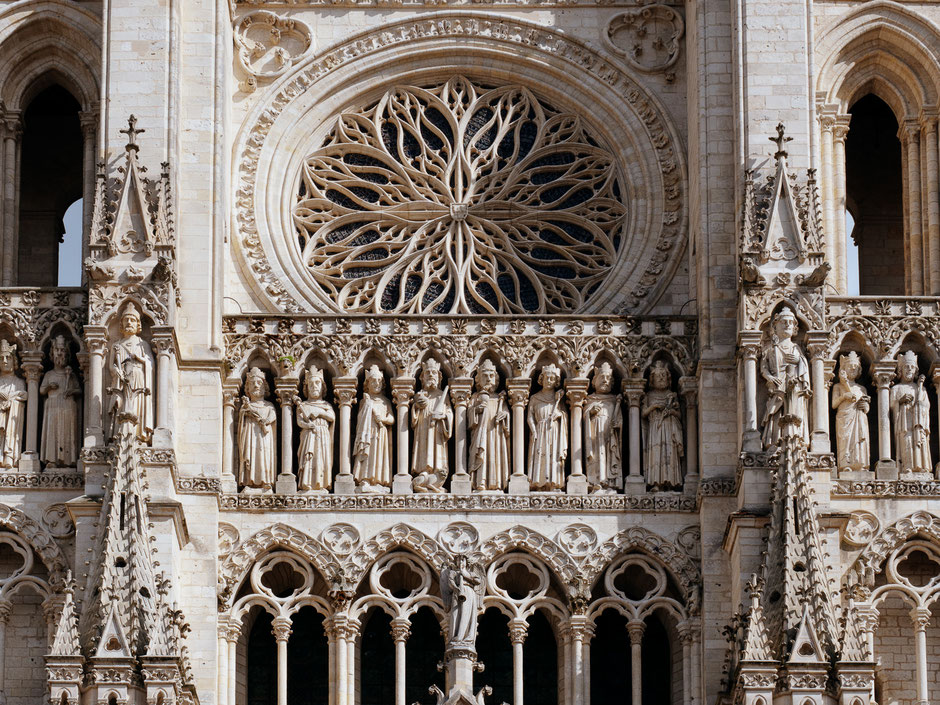
2. SAINT-LEU & QUAI BÉLU
Located between the majestic Amiens Cathedral and the gentle waters of the Somme River, the Saint-Leu neighbourhood is one of the most picturesque areas of the city. Its narrow cobbled streets, colourful half-timbered houses, and lively atmosphere make it a must-visit destination for tourists and locals alike.
Saint-Leu's history dates back to the Middle Ages, when the district was built on the water's edge to house the city's many craftsmen and artists. Its location on the river allowed easy access to the mills that were crucial to the work of weavers, dyers, and tanners who flocked to the area. Today, Saint-Leu remains a hub of artistic activity, with many galleries and studios showcasing the works of local artists.
In the mid-twentieth century, the neighbourhood began to suffer from neglect, but the town council's decision to establish universities in the area breathed new life into Saint-Leu. This move attracted a young and dynamic population, and the neighbourhood regained its charm and vitality. In the 1990s, a comprehensive revitalization plan was put in place, including the demolition of some old buildings and the creation of new public spaces such as Quai Bélu, a lively riverside promenade lined with restaurants, bars, and theaters. Today, Saint-Leu is a vibrant and cosmopolitan neighbourhood that showcases the best of Amiens' cultural and architectural heritage.




3. HORTILLONNAGES
As mentioned earlier, while Amiens is well-known for having the largest Cathedral in France, it is the Hortillonnages that truly make the city stand out! Often referred to as the "green lungs" of Amiens, the Hortillonnages are located just a few steps away from the old town, yet offer a tranquil and peaceful environment that is surprising to find so close to the bustling city center.
Let's now dive into the history of the Hortillonnages! These lush wetlands and tiny islands on the Somme river were already a prime location for Roman vegetable cultivation. Back then, the Hortillonnages sprawled beyond their current boundaries, covering a whopping 10,000 hectares. But over time, their size dwindled. By 1900, they had shrunk to a mere 500 hectares, and today, they span 300 hectares. Despite this dramatic decrease in size, the Hortillonnages have thankfully managed to avoid being wiped off the map entirely!
Exploring the Hortillonnages by foot may seem tempting, but trust me, the only way to truly experience these enchanting floating gardens is by hopping aboard one of the iconic "barques à cornets" (horn-shaped boats). These traditional boats are equipped with eco-friendly electric motors that won't harm the local flora and fauna. During your 45-minute journey, a knowledgeable boatman will steer you through the intricate network of canals, regaling you with fascinating stories about the history of this place.
The Hortillonnages offer a diverse landscape that can transport you to a magical forest with soaring trees and birdsong, or to an open garden adorned with breathtaking wildflowers and perfectly manicured lawns. Along the way, you'll come across charming cottages and huts that have been passed down from one generation to the next, adding to the area's rustic charm.
| Opening hours |
daily from 9 a.m. to 12. p.m.
and from 1.30 p.m. to 6 p.m.
(from April 1 to October 31)
| Admission - 5.90 EUR |

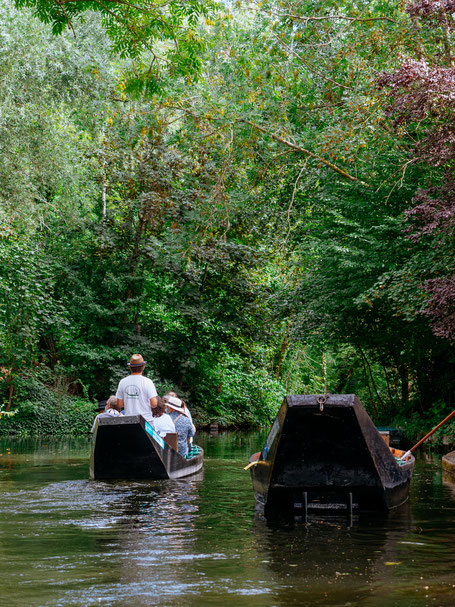


OTHER PLACES TO VISIT
Amiens is a city rich in history and culture, and while the Cathedral, Saint-Leu, and the Hortillonnages are certainly the highlights, there’s much more to discover. If you have a little extra time, here are two more must-see spots that will give you a deeper glimpse into the city's heritage and artistic spirit.
MUSEUM OF PICARDIE
The Museum of Picardie, or Musée de Picardie, is a fantastic place to explore both art and history, and it is one of the top museums in the region. Located in a stunning old building, the museum takes you on a journey through time, from ancient history to modern art. Inside, you'll see everything from ancient Greek and Roman objects to paintings by famous European artists like El Greco and Corot. It's a place where history feels alive, and every room tells a different story. Whether you're passionate about art or just interested in learning more about the history of Picardie, this museum is sure to impress. Plus, it's a great place to visit if the weather isn't the best!
| Opening hours |
Tues. to Fri. from 9.30 a.m. to 6 p.m.
Sat. & Sun. from 11 a.m. to 6 p.m.
| Admission - 9 EUR (or combined ticket with House of Jules Verne: 16 EUR) |
HOUSE OF JULES VERNE
If you're a fan of literature, you cannot miss the House of Jules Verne. The author of Around the World in Eighty Days and Twenty Thousand Leagues Under the Sea lived in Amiens for more than 18 years. Today, his house has been transformed into a museum where visitors can enter the creative world of one of France's greatest writers. A tour of the rooms where Verne lived and worked will give you an insight into his vivid imagination, as well as his daily life. From his collection of curiosities to his office full of books and manuscripts, the house is a time capsule of 19th-century innovation and literary genius. For fans of science fiction and adventure, this visit is a dream come true!
| Opening hours |
from 10 a.m. to 12.30 a.m.
& 2 p.m. to 6 p.m. (closed on Tuesdays)
| Admission - 9 EUR (or combined ticket with Museum of Picardie: 16 EUR) |


Travel Essentials
GETTING THERE
BY TRAIN
Traveling to Amiens by train is one of the easiest and most efficient ways to reach the city. With over 20 daily return trips, the train connections are frequent and reliable. From Paris, the journey takes about 1 hour, making it a perfect option for a day trip or weekend getaway. Trains from Lille take roughly 1 hour and 20 minutes. Amiens train station is conveniently located just a short walk from the historic city center, allowing visitors to quickly start exploring upon arrival. You can book tickets through the SNCF website, often with discounted fares if you book in advance.
BY BUS
Buses offer an affordable alternative to trains and cars, especially for travelers coming from nearby towns or smaller cities. Regional bus companies such as FlixBus and local transport services operate routes to Amiens from places like Beauvais, Compiègne, and other parts of Hauts-de-France. Bus ticket prices generally range from 5 to 15 EUR, depending on the distance and service provider. Though less frequent than trains, buses can be a good option for budget travelers or those with flexible schedules. For up-to-date routes and schedules, check websites like FlixBus or the official Amiens public transport site.
BY CAR
For those who prefer flexibility or are coming from nearby regions, driving to Amiens is straightforward. The city is well-connected by major highways and motorways. From Paris, it’s about a 1 hour and 30-minute drive via the A16 and A29 highways. Lille is roughly 1 hour and 40 minutes away, while Reims can be reached in about 2 hours. Rouen is about a 1 hour and 30-minute drive. Parking is available in several city center parking lots, including both underground and surface options, usually costing around 2 to 3 EUR per hour. Renting a car can be a great way to explore the surrounding Picardy region as well.
EATING THERE
LUNCH LOCATIONS
- Break: Enjoy a menu that changes every day at Break, with homemade dishes made by two caring women. Prices
are usually between 10 and 15 EUR. Their banoffee dessert is a favorite and a must-try!
- Snack El Balad: Taste the fresh and bold flavors of Lebanon at Snack El
Balad. They offer tasty takeaway food starting at about 5 EUR. Be sure to try their famous garlic fries — they’re delicious!
- Pho du Dragon: Take a trip to Asia with a visit to Pho du Dragon, where you can enjoy tasty dishes like
ramen and other authentic flavors. Main meals cost between 10 and 15 EUR.
- Carte Blanche: Have lunch at this special restaurant where your meal helps a good cause. Main dishes are
priced between 10 and 20 EUR, making it a great place to eat with meaning.
BRUNCH PLACES
- Robin Room: Visit the stylish Robin Room for creative dishes in a lively setting. Prices usually range from 15 to 25 EUR per
dish. They also have a brunch menu for 25 EUR per person, making it a great place for a tasty meal!
- Le Colibri: Enjoy a lovely brunch with a 32 EUR menu that includes a savory dish, a sweet pastry, a fresh drink, and a hot beverage. The cozy atmosphere and great pastries make it a
perfect spot.
- Yolanda: Relax at Yolanda for a cozy brunch with fresh, local ingredients and classic breakfast dishes from around the world. They also offer
creative vegetarian options in a warm, friendly space. Prices usually range from 15 to 25 EUR.
DRINKING SPOTS
- Café Pinson: Enjoy a mix of flavors at Café Pinson, with a wide range of homemade treats. Try their charcuterie and
mixed platters, paired with wines, beers, and other drinks.
- Green Corner: Savor homemade dishes
like hummus, cheese platters, and pork terrine with Maroilles cheese. Pair your meal with fresh juices, classic cocktails, or fine wines for a full experience.
DINING PLACES
- Chez Rosa: Savor authentic Italian flavors at Chez Rosa, well-known for its delicious, wood-fired
pizzas. Prices typically range from 12 to 20 EUR, depending on your choice of toppings.
- La Manufacture: This cozy brasserie serves traditional regional dishes, including the
popular Welsh rarebit. Main courses cost between 15 and 25 EUR.
- Okinawa: Enjoy an all-you-can-eat dinner of fresh sushi, sashimi, and ramen for just 24.90
EUR. Perfect for a casual, filling meal with specialty rolls and comforting bowls.
- Ail des ours: Try high-end
French cooking at Ail des Ours, known for its seasonal dishes and Michelin recognition. Dinner menus range from 48 to 60 EUR for a special dining experience.
BAKERIES AND TREATS
- Jean
Trogneux: Treat yourself to the iconic French macarons from Jean Trogneux, a beloved patisserie made of almond, sugar, egg, and honey-based
recipe, deeply rooted in the culinary heritage of the Hauts-de-France region. Prices start at 1.50 EUR per macaron, allowing you to savor the rich history and flavors of the region's celebrated
delicacy.
- Les spécialités de Quesnoy-le-Montant / Maison Fréville:
Discover regional flavors at Maison Fréville in Quesnoy-le-Montant, where you can try the Gateau Battu, a local
favorite.
- Les Gâteaux de Margot: Enjoy fresh pastries in a cozy, welcoming café run by the same team
behind Le Colibri. It’s a perfect spot for a sweet treat or coffee with friends. Prices are about 5-6 EUR.
- Crémence: Crémence Pâtisserie offers eight changing pastries each month, known for low-sugar, refined
desserts. Pastries cost about 5 EUR, cookies 4 EUR, and special treats like Crookies and Chocownies 3.90 EUR.
FINAL THOUGHTS
As someone who grew up in Amiens, I love rediscovering my hometown through the eyes of a tourist — it’s always surprising how much there is to uncover. Often overlooked, Amiens is a city full of charm and rich history. While this post highlights just three main attractions, there’s so much more waiting to be explored. Be sure to check out our dedicated post on the Notre-Dame d’Amiens Cathedral (read it here), and don’t miss other gems like the Museum of Picardie and the House of Jules Verne.
We’d love to hear from you! Have you had the chance to visit Amiens? Share your experiences, favorite places, or tips in the comments section below. We’re excited to hear what you think!






